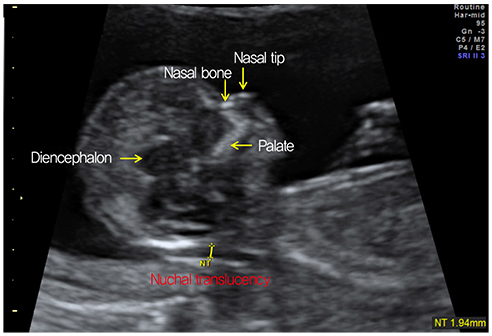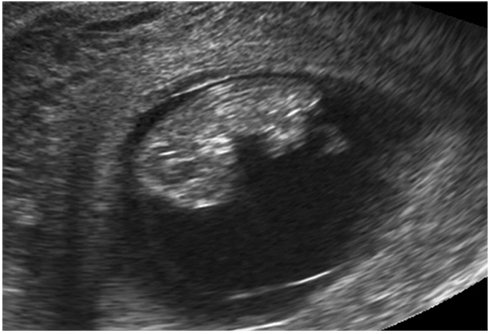Obstet Gynecol Sci.
2015 Jan;58(1):1-9. 10.5468/ogs.2015.58.1.1.
2014 First-trimester ultrasound forum from the Korean Society of Ultrasound in Obstetrics and Gynecology
- Affiliations
-
- 1Department of Obstetrics and Gynecology, Samsung Medical Center, Sungkyunkwan University School of Medicine, Seoul, Korea.
- 2Department of Obstetrics and Gynecology, Seoul National University Bundang Hospital, Seongnam, Korea.
- 3Department of Obstetrics and Gynecology, Kyung Hee University School of Medicine, Seoul, Korea.
- 4Division of Maternal and Fetal Medicine, Department of Obstetrics and Gynecology, Konkuk University Medical Center, Konkuk University School of Medicine, Seoul, Korea.
- 5Department of Obstetrics and Gynecology, Graduate School of Medicine, Dongguk University, Seoul, Korea.
- 6Hamchoon Women's Clinic, Seoul, Korea.
- 7Department of Obstetrics and Gynecology, Seoul St. Mary's Hospital, The Catholic University of Korea College of Medicine, Seoul, Korea.
- 8Department of Obstetrics and Gynecology, Kwandong University College of Medicine, Seoul, Korea.
- 9Department of Obstetrics and Gynecology, Ewha Womans University School of Medicine, Seoul, Korea.
- 10Department of Obstetrics and Gynecology, Korea University College of Medicine, Seoul, Korea.
- 11Department of Obstetrics and Gynecology, Seoul National University College of Medicine, Seoul, Korea.
- 12Department of Obstetrics and Gynecology, Bucheon St. Mary's Hospital, The Catholic University of Korea College of Medicine, Bucheon, Korea. ksajin@catholic.ac.kr
- KMID: 1994220
- DOI: http://doi.org/10.5468/ogs.2015.58.1.1
Abstract
- A first-trimester ultrasound scan has become an essential part of antenatal care. The Korean Society of Ultrasound in Obstetrics and Gynecology held a first-trimester ultrasound forum on April 5, 2014. The forum aimed to present an updated review of the literature on the topic of first-trimester ultrasound in specific lectures and to host a panel discussion on several important issues regarding first-trimester scans. The forum provided evidence- and consensus-based best practice patterns for obstetricians in Korea. Here, we report the review and checklists presented from the forum.
Keyword
MeSH Terms
Figure
Cited by 1 articles
-
Screening ultrasonography in pregnancy
Ba-Da Jeong, Hye-Sung Won
J Korean Med Assoc. 2015;58(11):1003-1010. doi: 10.5124/jkma.2015.58.11.1003.
Reference
-
1. Nicolaides KH, Azar G, Byrne D, Mansur C, Marks K. Fetal nuchal translucency: ultrasound screening for chromosomal defects in first trimester of pregnancy. BMJ. 1992; 304:867–869.2. Snijders RJ, Noble P, Sebire N, Souka A, Nicolaides KH. UK multicentre project on assessment of risk of trisomy 21 by maternal age and fetal nuchal-translucency thickness at 10-14 weeks of gestation: Fetal Medicine Foundation First Trimester Screening Group. Lancet. 1998; 352:343–346.3. Wald NJ, Rodeck C, Hackshaw AK, Walters J, Chitty L, Mackinson AM. First and second trimester antenatal screening for Down's syndrome: the results of the Serum, Urine and Ultrasound Screening Study (SURUSS). J Med Screen. 2003; 10:56–104.4. Nicolaides KH, Spencer K, Avgidou K, Faiola S, Falcon O. Multicenter study of first-trimester screening for trisomy 21 in 75 821 pregnancies: results and estimation of the potential impact of individual risk-orientated two-stage first-trimester screening. Ultrasound Obstet Gynecol. 2005; 25:221–226.5. Wald NJ, Cuckle HS, Densem JW, Nanchahal K, Royston P, Chard T, et al. Maternal serum screening for Down's syndrome in early pregnancy. BMJ. 1988; 297:883–887.6. Souka AP, Von Kaisenberg CS, Hyett JA, Sonek JD, Nicolaides KH. Increased nuchal translucency with normal karyotype. Am J Obstet Gynecol. 2005; 192:1005–1021.7. Hyett J, Perdu M, Sharland G, Snijders R, Nicolaides KH. Using fetal nuchal translucency to screen for major congenital cardiac defects at 10-14 weeks of gestation: population based cohort study. BMJ. 1999; 318:81–85.8. Kim MH, Park SH, Cho HJ, Choi JS, Kim JO, Ahn HK, et al. Threshold of nuchal translucency for the detection of chromosomal aberration: comparison of different cut-offs. J Korean Med Sci. 2006; 21:11–14.9. Souka AP, Snijders RJ, Novakov A, Soares W, Nicolaides KH. Defects and syndromes in chromosomally normal fetuses with increased nuchal translucency thickness at 10-14 weeks of gestation. Ultrasound Obstet Gynecol. 1998; 11:391–400.10. Nicolaides KH. First-trimester screening for chromosomal abnormalities. Semin Perinatol. 2005; 29:190–194.11. Pandya PP, Kondylios A, Hilbert L, Snijders RJ, Nicolaides KH. Chromosomal defects and outcome in 1015 fetuses with increased nuchal translucency. Ultrasound Obstet Gynecol. 1995; 5:15–19.12. Mol BW. Down's syndrome, cardiac anomalies, and nuchal translucency. BMJ. 1999; 318:70–71.13. Ayras O, Tikkanen M, Eronen M, Paavonen J, Stefanovic V. Increased nuchal translucency and pregnancy outcome: a retrospective study of 1063 consecutive singleton pregnancies in a single referral institution. Prenat Diagn. 2013; 33:856–862.14. Bellotti M, Fesslova V, De Gasperi C, Rognoni G, Bee V, Zucca I, et al. Reliability of the first-trimester cardiac scan by ultrasound-trained obstetricians with high-frequency transabdominal probes in fetuses with increased nuchal translucency. Ultrasound Obstet Gynecol. 2010; 36:272–278.15. Nicolaides KH. Nuchal translucency and other first-trimester sonographic markers of chromosomal abnormalities. Am J Obstet Gynecol. 2004; 191:45–67.16. Malone FD, Ball RH, Nyberg DA, Comstock CH, Saade GR, Berkowitz RL, et al. First-trimester septated cystic hygroma: prevalence, natural history, and pediatric outcome. Obstet Gynecol. 2005; 106:288–294.17. Scholl J, Durfee SM, Russell MA, Heard AJ, Iyer C, Alammari R, et al. First-trimester cystic hygroma: relationship of nuchal translucency thickness and outcomes. Obstet Gynecol. 2012; 120:551–559.18. Rossi AC, Prefumo F. Accuracy of ultrasonography at 11-14 weeks of gestation for detection of fetal structural anomalies: a systematic review. Obstet Gynecol. 2013; 122:1160–1167.19. Katorza E, Achiron R. Early pregnancy scanning for fetal anomalies: the new standard? Clin Obstet Gynecol. 2012; 55:199–216.20. Kontopoulos E, Odibo A, Wilson RD. Current controversies in prenatal diagnosis 2: are we ready to screen for fetal anomalies with first trimester ultrasound? Prenat Diagn. 2013; 33:9–12.21. Syngelaki A, Chelemen T, Dagklis T, Allan L, Nicolaides KH. Challenges in the diagnosis of fetal non-chromosomal abnormalities at 11-13 weeks. Prenat Diagn. 2011; 31:90–102.22. Sepulveda W, Wong AE. First trimester screening for holoprosencephaly with choroid plexus morphology ('butterfly' sign) and biparietal diameter. Prenat Diagn. 2013; 33:1233–1237.23. Kagan KO, Staboulidou I, Syngelaki A, Cruz J, Nicolaides KH. The 11-13-week scan: diagnosis and outcome of holoprosencephaly, exomphalos and megacystis. Ultrasound Obstet Gynecol. 2010; 36:10–14.24. Khalil A, Arnaoutoglou C, Pacilli M, Szabo A, David AL, Pandya P. Outcome of fetal exomphalos diagnosed at 11-14 weeks of gestation. Ultrasound Obstet Gynecol. 2012; 39:401–406.25. Tassin M, Descriaud C, Elie C, Houfflin Debarge V, Dumez Y, Perrotin F, et al. Omphalocele in the first trimester: prediction of perinatal outcome. Prenat Diagn. 2013; 33:497–501.26. David AL, Tan A, Curry J. Gastroschisis: sonographic diagnosis, associations, management and outcome. Prenat Diagn. 2008; 28:633–644.27. Amato JJ, Douglas WI, Desai U, Burke S. Ectopia cordis. Chest Surg Clin N Am. 2000; 10:297–316.28. Sebire NJ, Von Kaisenberg C, Rubio C, Snijders RJ, Nicolaides KH. Fetal megacystis at 10-14 weeks of gestation. Ultrasound Obstet Gynecol. 1996; 8:387–390.29. Liao AW, Sebire NJ, Geerts L, Cicero S, Nicolaides KH. Megacystis at 10-14 weeks of gestation: chromosomal defects and outcome according to bladder length. Ultrasound Obstet Gynecol. 2003; 21:338–341.30. Sepulveda W. Megacystis in the first trimester. Prenat Diagn. 2004; 24:144–149.31. Al-Hazmi H, Dreux S, Delezoide AL, Dommergues M, Lortat-Jacob S, Oury JF, et al. Outcome of prenatally detected bilateral higher urinary tract obstruction or megacystis: sex-related study on a series of 709 cases. Prenat Diagn. 2012; 32:649–654.32. Comstock CH. Normal fetal heart axis and position. Obstet Gynecol. 1987; 70:255–259.33. Souka AP, Pilalis A, Kavalakis Y, Kosmas Y, Antsaklis P, Antsaklis A. Assessment of fetal anatomy at the 11-14-week ultrasound examination. Ultrasound Obstet Gynecol. 2004; 24:730–734.34. McBrien A, Howley L, Yamamoto Y, Hutchinson D, Hirose A, Sekar P, et al. Changes in fetal cardiac axis between 8 and 15 weeks' gestation. Ultrasound Obstet Gynecol. 2013; 42:653–658.35. Reed SD, Hall JG, Riccardi VM, Aylsworth A, Timmons C. Chromosomal abnormalities associated with congenital contractures (arthrogryposis). Clin Genet. 1985; 27:353–372.36. Sepulveda W, Treadwell MC, Fisk NM. Prenatal detection of preaxial upper limb reduction in trisomy 18. Obstet Gynecol. 1995; 85(5 Pt 2):847–850.37. Nelson TR, Fowlkes JB, Abramowicz JS, Church CC. Ultrasound biosafety considerations for the practicing sonographer and sonologist. J Ultrasound Med. 2009; 28:139–150.38. US Food and Drug Administration. Fetal keepsake videos [Internet]. Silver Spring: US Food and Drug Administration;cited 2014 Oct 8. Available from: http://www.fda.gov/MedicalDevices/Safety/AlertsandNotices/PatientAlerts/ucm064756.htmhttp://www.fda.gov/MedicalDevices/Safety/AlertsandNotices/PatientAlerts/ucm064756.htm.39. The British Medical Ultrasound Society. Guidelines for the safe use of diagnostic ultrasound equipment [Internet]. London: The British Medical Ultrasound Society;cited 2014 Oct 8. Available from: http://fetalanomaly.screening.nhs.uk/fetalanomalyresource/images/stories/Downloads/2.5.1_safe_environment/bmus-safety-guidelines-2009-revision-final-nov-2009.pdf.40. Johnson MP, Johnson A, Holzgreve W, Isada NB, Wapner RJ, Treadwell MC, et al. First-trimester simple hygroma: cause and outcome. Am J Obstet Gynecol. 1993; 168(1 Pt 1):156–161.41. Ville Y. Nuchal translucency in the first trimester of pregnancy: ten years on and still a pain in the neck? Ultrasound Obstet Gynecol. 2001; 18:5–8.42. Cicero S, Avgidou K, Rembouskos G, Kagan KO, Nicolaides KH. Nasal bone in first-trimester screening for trisomy 21. Am J Obstet Gynecol. 2006; 195:109–114.43. Has R, Kalelioglu I, Yuksel A, Ibrahimoglu L, Ermis H, Yildirim A. Fetal nasal bone assessment in first trimester down syndrome screening. Fetal Diagn Ther. 2008; 24:61–66.44. Moon MH, Cho JY, Lee YM, Lee YH, Yang JH, Kim MY, et al. Nasal bone length at 11-14 weeks of pregnancy in the Korean population. Prenat Diagn. 2006; 26:524–527.45. Malone FD, Ball RH, Nyberg DA, Comstock CH, Saade G, Berkowitz RL, et al. First-trimester nasal bone evaluation for aneuploidy in the general population. Obstet Gynecol. 2004; 104:1222–1228.
- Full Text Links
- Actions
-
Cited
- CITED
-
- Close
- Share
- Similar articles
-
- Ultrasound Detection of Chromosomal Anomalies in the Second and Third Trimester
- Spontaneous Uterine Rupture during Second Trimester Pregnancy after High-intensity Focused Ultrasound
- The Problem of Forced Insurance Coverage on Prenatal Ultrasound
- Two cases of adnexal torsion during the third trimester of pregnant women
- The clinical practice patterns of fetal ultrasonography in the first-trimester: A questionnaire survey of members of the Korean Society of Ultrasound in Obstetrics and Gynecology





